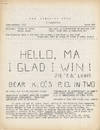
Bonmokyo koshakuki ("Commentary on the Brahma's Net Sutra").: Kan ge matsu ("Final Part").
by JAPANESE EARLY PRINTING
- Used
- Condition
- See description
- Seller
-
London, United Kingdom
Payment Methods Accepted
About This Item
Nara: Saidai Temple,, [c.1315]. The effervescence of Japanese Buddhism during the Kamakura period An extraordinary survival, from the Hawley library, of East Asia's transnational history, bringing together a foundational Chinese sutra and a leading Korean exegesis in a Japanese context. This is an example of the printing undertaken at the famous Saidai Temple in Nara at the close of Japan's Kamakura period (1183-1333). During the late 12th and early 13th centuries, the temple printed a number of now exceptionally rare religious texts. "It was in the Kamakura period that Buddhism in Japan came into full flower" (Kazuo & Dobbinst). Composed in China around 420, the Brahma's Net Sutra (Brahmajala Sutra) is based on Mahayana and Hinayana Buddhist teachings and incorporates important Chinese moral and ethical ideas such as filial piety. The present commentary composed by the Korean monk Taehyon in the eighth century remains "the most thorough and balanced exegesis ever written on the text" (Muller, p. xxxvii) and exemplifies the leading role played by Koreans in the flourishing of East Asian Buddhism in the second half of the first millennium CE. The Saidai Temple was founded in 765 in Nara, the centre of Japanese Buddhist culture, and was one of the city's seven leading temples. In the 13th century, it was established as the headquarters of the Shingon Risshu sect founded by the monk Eison (1201-1290). Under Eison's stewardship, the temple printed xylographic editions of sutras often distinctively bound as concertinas rather than in the more traditional scroll format. Printing continued after his death until at least 1318. Provenance: "Horei bunko" ownership seal of the book collector Frank Hawley (1906-1961) at the conclusion of the text. One of the leading Western collectors of Japanese books in the 20th century, Hawley began to disperse his library, some 10,000 books, following the Second World War. Tenri Central Library holds 431 items related to Japanese paper (washi), while the University of Hawaii holds 936 of Hawley's books on Ryukyu. We acquired this copy from a private collector in the UK. Slim quarto, concertina-style (292 x 94 mm). 40 xylographic sheets, joined sequentially with adhesive as issued, original orange paper covers, front cover with black manuscript title. Housed in custom folding case with manuscript title labels. Red and black manuscript reading marks in text. Covers worn and wormed with manuscript title heavily affected, old tidemarks and worming to contents, neat paper repairs to verso, text well-preserved. A very good example. Osumi Kazuo & Jamest C. Dobbinst, "Buddhism in the Kamakura Period", available online; A. Charles Muller (ed.), Exposition of the Sutra of Brahma's Net, 2011.
Reviews
(Log in or Create an Account first!)
Details
- Bookseller
- Peter Harrington
(GB)
- Bookseller's Inventory #
- 160293
- Title
- Bonmokyo koshakuki ("Commentary on the Brahma's Net Sutra").
- Author
- JAPANESE EARLY PRINTING
- Book Condition
- Used
- Place of Publication
- Nara: Saidai Temple,
- Date Published
- [c.1315]
Terms of Sale
Peter Harrington
All major credit cards are accepted. Both UK pounds and US dollars (exchange rate to be agreed) accepted. Books may be returned within 14 days of receipt for any reason, please notify first of returned goods.
About the Seller
Peter Harrington
Biblio member since 2006
London
About Peter Harrington
Since its establishment, Peter Harrington has specialised in sourcing, selling and buying the finest quality original first editions, signed, rare and antiquarian books, fine bindings and library sets. Peter Harrington first began selling rare books from the Chelsea Antiques Market on London's King's Road. For the past twenty years the business has been run by Pom Harrington, Peter's son.




